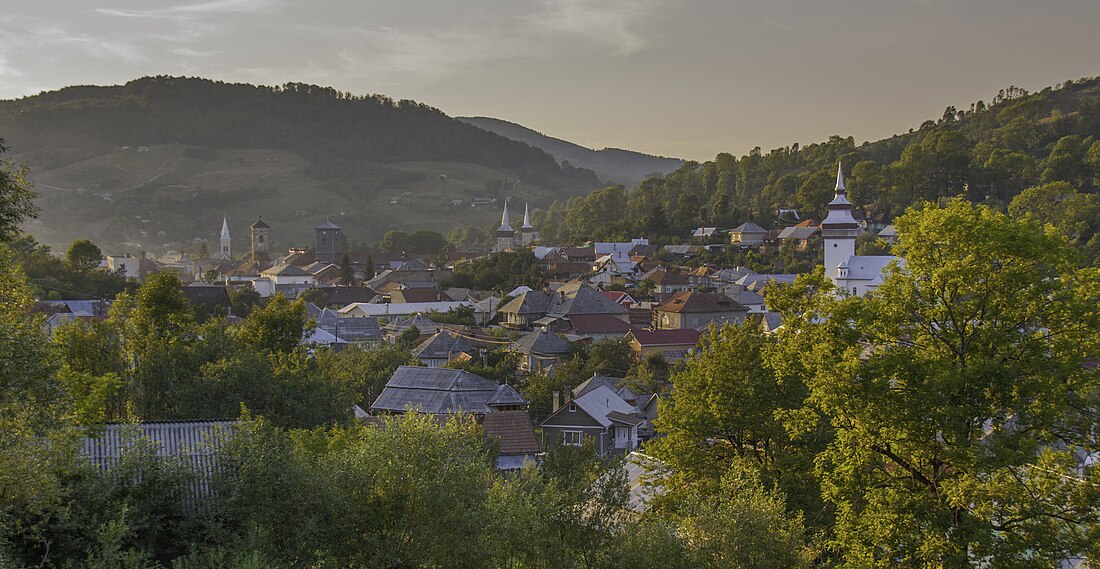Abrud
Town in Alba, Romania From Wikipedia, the free encyclopedia
Abrud (Latin: Abruttus;[3] Hungarian: Abrudbánya; German: Großschlatten) is a town in the north-western part of Alba County, Transylvania, Romania, located on the river Abrud. It administers three villages: Abrud-Sat (Abrudfalva), Gura Cornei (Szarvaspataktorka) and Soharu (Szuhár).
Abrud | |
|---|---|
 | |
 Location in Alba County | |
| Coordinates: 46°16′26″N 23°3′48″E | |
| Country | Romania |
| County | Alba |
| Government | |
| • Mayor (2020–2024) | Cristian Albu[1] (PNL) |
Area | 32.00 km2 (12.36 sq mi) |
| Elevation | 627 m (2,057 ft) |
| Population (2021-12-01)[2] | 4,360 |
| • Density | 140/km2 (350/sq mi) |
| Time zone | EET/EEST (UTC+2/+3) |
| Postal code | 515100 |
| Area code | (+40) 02 58 |
| Vehicle reg. | AB |
| Website | www |
Population
| Year | Pop. | ±% |
|---|---|---|
| 1912 | 2,938 | — |
| 1930 | 2,468 | −16.0% |
| 1948 | 2,656 | +7.6% |
| 1956 | 4,411 | +66.1% |
| 1966 | 5,150 | +16.8% |
| 1977 | 5,315 | +3.2% |
| 1992 | 6,729 | +26.6% |
| 2002 | 6,803 | +1.1% |
| 2011 | 4,944 | −27.3% |
| 2021 | 4,360 | −11.8% |
| Source: INS, Census data | ||
At the 2021 census, Abrud had a population of 4,360. According to the census from 2011, the town had a total population of 4,944; of those, 96.66% were ethnic Romanians, 0.86% ethnic Hungarians, and 0.53% ethnic Romani.[4]
Name
The name came from the ancient name of the Abrud river. Although first recorded only in 1271 in the form terra Obruth, the name of the town might have derived from a hypothetical Dacian word for gold: "obrud".[5] The Hungarian name is Abrudbánya ("bánya" means mine in Hungarian). According to Hungarian linguists, the town's modern name reflects a characteristic vowel shift in the medieval Hungarian language which occurred in the 14th century. The Romanian name Abrud was borrowed from the Hungarian form, the transformation of Obruth to Abrud reflects the typically Hungarian vowel shift (from o to a) as in the case of the Szamos and Maros rivers. If the ancient form had survived directly in the Romanian language, then according to the Romanian linguistic rules it would have produced Aurud.[6] According to Romanian linguist Nicolae Drăganu, the earlier form of the Hungarian name was Obruth and Obrudbania which was a Greek variant of a Thracian word. He states that the Romanian form (a) came from the romanized Dacians, while the Hungarian form (o) came from the Daco-Romans through Slavic mediation.[7]
History
Summarize
Perspective
Antiquity
The Romans erected a small fortification here in the 2nd century AD.[8] It was part of the defence system of the gold mines nearby, in "Alburnus Maior" (nowadays, Roșia Montană),[citation needed] but it was abandoned in the 3rd century.[8]
Middle Ages
Abrud was first recorded in 1271 in as terra Obruth.[5] It gained town status in 1427.
18th-century revolts
In 1727, the leaders of a revolt gained control of the town. Another serfs' revolt began in the area in 1784 with Horea, Cloșca and Crișan as leaders fighting the Austrian Imperial forces. Abrud was captured by the uprising's members on 6 November, before the revolt was crushed by the Austrian army.
1848 revolution
During the Hungarian Revolution of 1848, negotiations took place in Abrud between the leaders of the Romanian peasants, led by Avram Iancu and Ion Dragoș, the envoy of Lajos Kossuth, deputy of Bihar County in the Parliament of Budapest, regarding the conciliation of the Romanian and Hungarian revolutionary forces. On 6 May, in violation of the negotiated armistice, Major Imre Hatvani conducted a one-way action without any compliance by attacking and occupying Abrud which triggered the Abrud massacre. Hatvani embarked also on unnecessary killings, hanged Romanian lawyer Ioan Buteanu, while his drunken soldiers massacred prefect Petru Dobra. In the next two weeks 88 Romanians were killed in the central square, and around 2,500 Hungarians were killed in revenge by Iancu's army in Abrud and in Roșia Montană; Dragoș was also killed, being considered a traitor.[9] The escalated conflict could not be settled, Abrud was conquered and lost several times by the Hungarian troops, until 18 May when they retreated to Arad.[10]
Natives
Climate
Abrud has a humid continental climate (Cfb in the Köppen climate classification).
| Climate data for Abrud | |||||||||||||
|---|---|---|---|---|---|---|---|---|---|---|---|---|---|
| Month | Jan | Feb | Mar | Apr | May | Jun | Jul | Aug | Sep | Oct | Nov | Dec | Year |
| Mean daily maximum °C (°F) | 0.8 (33.4) |
2.8 (37.0) |
7.4 (45.3) |
13.7 (56.7) |
18 (64) |
21.2 (70.2) |
22.9 (73.2) |
23.3 (73.9) |
18.4 (65.1) |
13.2 (55.8) |
7.9 (46.2) |
2.2 (36.0) |
12.6 (54.7) |
| Daily mean °C (°F) | −2.7 (27.1) |
−1.1 (30.0) |
3.1 (37.6) |
9 (48) |
13.6 (56.5) |
17 (63) |
18.7 (65.7) |
19 (66) |
14.2 (57.6) |
9 (48) |
4.2 (39.6) |
−1 (30) |
8.6 (47.4) |
| Mean daily minimum °C (°F) | −5.9 (21.4) |
−4.7 (23.5) |
−1.2 (29.8) |
3.9 (39.0) |
8.5 (47.3) |
11.9 (53.4) |
13.8 (56.8) |
14.2 (57.6) |
10 (50) |
5.2 (41.4) |
1.2 (34.2) |
−3.8 (25.2) |
4.4 (40.0) |
| Average precipitation mm (inches) | 56 (2.2) |
53 (2.1) |
71 (2.8) |
97 (3.8) |
131 (5.2) |
149 (5.9) |
149 (5.9) |
108 (4.3) |
84 (3.3) |
62 (2.4) |
60 (2.4) |
66 (2.6) |
1,086 (42.9) |
| Source: https://en.climate-data.org/europe/romania/alba/abrud-44395/ | |||||||||||||
References
Wikiwand - on
Seamless Wikipedia browsing. On steroids.


